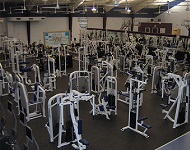
By Eric G. Bachman
A growing industry that has tremendous momentum is the fitness and sports industry. People are becoming more health conscious and are joining health and fitness facilities. In addition, athletes at all age level are participating in sport-specific training venues to enhance their skills through competition and private lessons. In my area, this highly profitable industry has grown tremendously over the years. When analyzing these venues for response potentials, each present numerous hazards and challenges.
Some of these venues specialize in specific activities, while others offer a variety of programs, equipment, and facilities. Their dispositions vary, from a small compartment in a strip mall to a large standalone establishment. Regardless of the venue’s size, fire officials must understand the challenges that these facilities present and develop mitigation contingencies.
Perception can often skew reality. A chief once remarked to me that the fitness center his department protected poses little risk because it contains “just a bunch of weights.” Although the content load may be perceived as low, there are many incident potentials that need assessing. Fires, hazardous material incidents, and other hazardous conditions reinforce the need to gather preincident intelligence on these facilities. This category is broad and can include a variety of facilities. This article will highlight some common hazards to spark your interest in preparing for emergencies at similar venues in your area.
HISTORY
Emergencies at athletic facilities can pose similar challenges common to other occupancies. However, that should not discount fire officials from aggressively improving intelligence on their unique challenges. Following are some incidents at health and fitness centers local to my area that posed varying degrees of severity and challenges.
- Lancaster, Pennsylvania (1999). An accidental fire started in a sauna at a health club causing more than $400,000 damage. The building was occupied at the time of the fire. One person became trapped and was successfully rescued.
- Lancaster, Pennsylvania (2003). An accidental fire, electrical in nature, ran through the ceiling void space and caused extensive damage to a health club. Although the facility was occupied, all patrons had been safely evacuated prior to the fire department’s arrival.
- Hershey, Pennsylvania (2005). An odor investigation found a chemical reaction involving bromine tablets that caused noxious fumes throughout the facility. The building was evacuated, the reaction was mitigated, and the fumes ventilated. There were no injuries.
- Cumberland, Pennsylvania (2006). A fitness center employee inadvertently mixed two pool chemicals together, causing a vapor cloud to permeate throughout the facility. Thirteen occupants—five employees and eight customers—were transported to and treated at local hospitals.
Although none of these incidents resulted in loss of life to civilians or firefighters, each presented site–specific challenges to the department. Regardless of the facility’s size, you must prepare by understanding what may be lying in wait and prepare contingencies accordingly.
RELATED: Norwood on Preplanning Inspections ‖ Pisciotta on Preplanning Construction Site Hazards ‖ Henke on Preplanning Incidents at Shopping Malls
DISPOSITION
Not all health and fitness centers are the same. Some are part of a nationwide chain (photo 1) while others are independently owned (photo 2). Some are small and operate in available spaces such as a shopping mall (photo 3) and others may be a locally-owned standalone (photo 4). Regardless of their disposition, they present challenges that must be identified, prepared for, and trained on. Although it is necessary to review factors common to all facilities such as construction, protection features, and utilities, other facility-specific hazards must be realized, analyzed, and prepared against.

(1) A chain fitness center anchoring a strip mall. (Photos by author.)

(2) A small, independently owned fitness facility operating in a former parts machining shop.

(3) A women’s fitness center in a strip mall.

(4) A locally owned standalone facility.
OCCUPANTS
When gathering intelligence on any facility, a common denominator is assessing occupants. That same chief, with the nonchalant “content load” remark, also reported that, “Those people are in shape; they will be able to get out.” Contrary to this perception, customers of all ages and mobility can be engaging in workouts and fitness programs. These facilities continuously expand their programs and offer special programs to draw in more customers.
Fitness programs for older patrons and kids are increasing. Facilities may offer child-care services so parents can participate in exercise programs. They may have playground mediums such as a tube-maze and ball pit (photo 5) designed for kids. How effective would your search be when working in and around this obstacle?

(5) Previously an indoor tennis court, this area has been converted to a child care area with a tube-maze, a slide, and a ball pit.
Athletic facilities also promote programs for older patrons. From muscle strength and range of movement programs to cardiovascular endurance building, there likely will be a wide range of self-preservation ability programs. The census of these facilities will also vary. A few or an extraordinary number customers may be on site at any given time, influencing search and rescue operations. Occupant accountability will also be problematic. In many cases, to gain access, members must “card into” the facility with a key fob or swiping a key card. However, in most cases, members do not “card out” of the facility, prohibiting accurate accountability.
SERVICES
This industry is highly competitive (no pun intended). Their business owners, like with any other industry, are constantly looking for ways to expand services and increase its cliental. Some may be equipped with aquatic facilities for water exercising or water sports (See Photo 6).
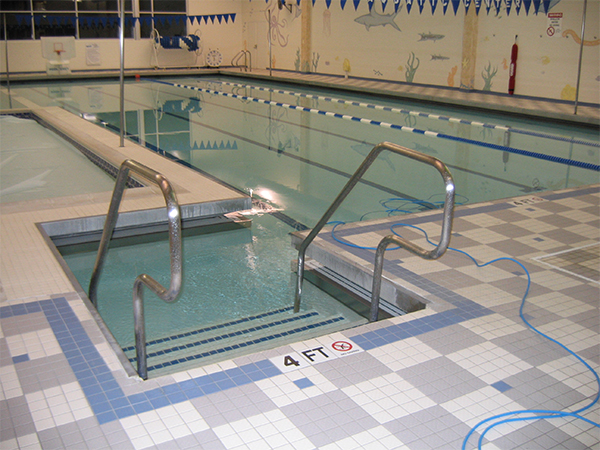
(6) A swimming pool at a health and fitness center.
LAYOUT
The layout of these facilities will vary. There may be large open spaces (photo 7) as well as small activity studios. There may also be many compartments such as sauna rooms and tanning rooms (photo 8). The layout disposition will play a vital role in all search and rescue, hoseline management, and ventilation.

(7) A large open exercise room.
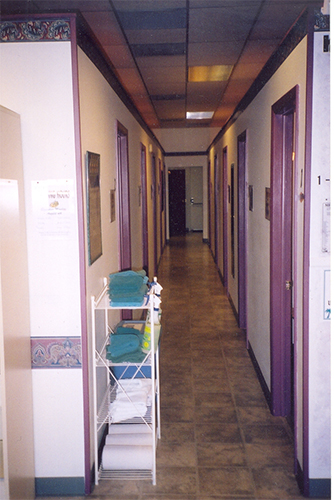
(8) Compartmentalized tanning and massage rooms.
Saunas, tanning beds, and other spa rooms may impede an occupant’s ability to recognize an emergency exists. Often, these individuals will have ear pieces for listening to music. This will reduce their ability to hear fire alarms and are not readily exit during an emergency.
SPECIAL HAZARDS
References to special hazards are broad. There can be many fall and entanglement hazards. Falling into a pool or a “plunge pit” (photo 9) at a gymnastics facility could cause search and rescue issues as well as hamper maneuvering hoselines. Weight racks and machines could topple over, adding a concentrated load and create additional stress to structural members.
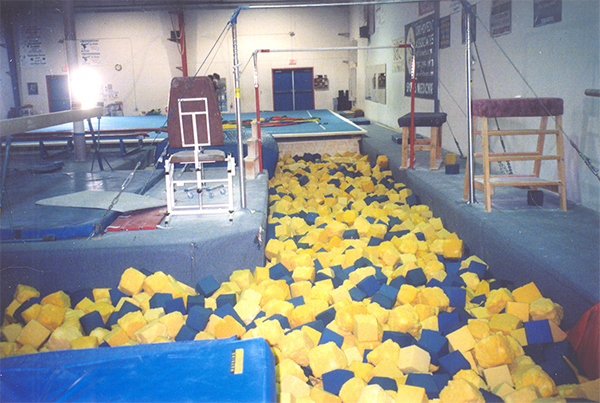
(9) A plunge pit can hamper fire department operations.
Entanglement hazards may also exist. Netting (photo 10) to prevent stray basketballs or baseballs from indoor courts and fields could easily fall from heat-compromised metal hangers. Hazardous material use is also of concern. As illustrated in the historical perspective earlier, two of the four incidents were chemical related. Fitness sites often house materials for cleaning and to support other activities and services such as pools and swimming. Pool operations and maintenance materials such as gaseous chlorine, hydrochloric acid, bromine, and sodium hypochlorite (photo 11) may be used. For hazardous material use, it is necessary for fire officials to obtain and review safety data sheets beforehand and to realize the physical and chemical hazards each presents.
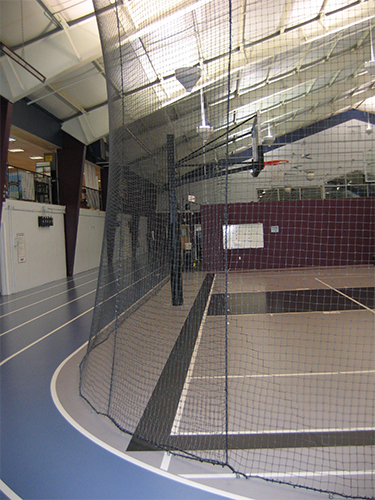
(10) This netting, hung by fragile metal hangars, spans the floor to the ceiling and helps contain stray basketballs from entering the indoor track.

(11) A 200-gallon tank of sodium hypochlorite used for treatment of pool water.
STORAGE AND HOUSEKEEPING
Housekeeping and storage practices can become a significant factor. Some rooms can have multiple uses; it may also need to be cleared to accommodate a group workout session. It may also be used as a classroom, requiring folding tables, chairs, and audio-visual equipment to be staged in nonideal locations (photo 12).
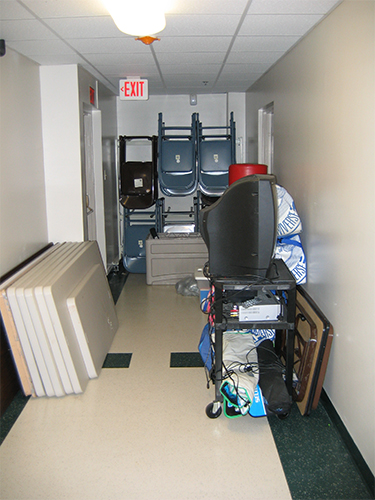
(12) Tables, chairs, and a television cart are staged in a hallway near an exit.
SPECIAL SYSTEMS
Other special systems may be in place such as elevators or Area of Rescue Assistance (ARA). An ARA, as part of the American with Disabilities Act (ADA), allows people with impairments to seek refuge at a specific location and through an identification system fire personnel can assist in vacating them from the premise. (For more information on ARAs, see my article in the January 2004 Fire Engineering, “Preplanning Special Systems: Areas of Rescue Assistance”)
These are just a few of the many other considerations associated with these facilities. A goal of the health and fitness industry is to coach their customers to improve their physical fitness. The fire service must apply that same drive to better train their firefighters for the potentials that exist through a consistent and exercised preincident intelligence program. Like physical conditioning at a health and fitness center, a practiced preincident intelligence program will improve a fire department’s ability to perform. Every facility that is protected, no matter how low the risk is perceived, must be analyzed to realize their clear and present hazards. It is imperative to go into all of the facilities you protect and see what challenges they present. You may be surprised at how “unfit” your department may be.
ERIC G. BACHMAN, CFPS, is a 33-year veteran of the fire service and a former chief of the Eden Volunteer Fire/Rescue Department in Lancaster County, Pennsylvania. He is the hazardous materials administrator for the County of Lancaster Emergency Management Agency and serves on the Local Emergency Planning Committee of Lancaster County. He is registered with the National Board on Fire Service Professional Qualifications as a fire officer IV, fire instructor III, hazardous materials technician, and hazardous materials incident commander. He has an associate degree in fire science and earned professional certification in emergency management through the state of Pennsylvania. He is also a volunteer firefighter with the West Hempfield (PA) Fire & Rescue Company.

